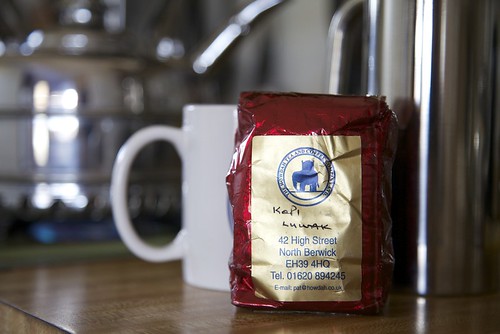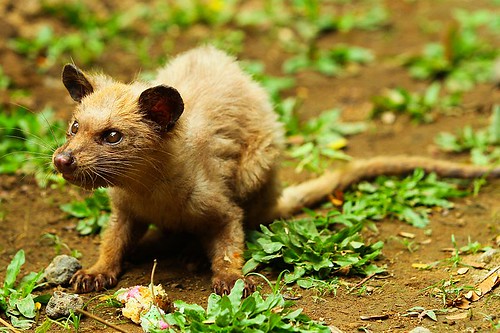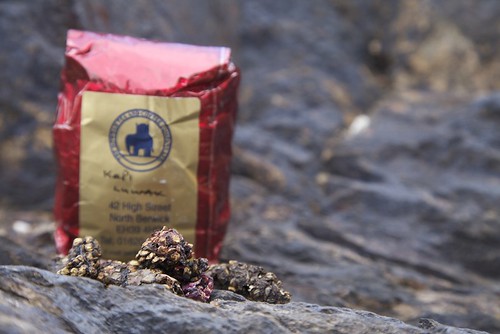THAT coffee . . .

I can claim with unimpeachable documentation to have been a fan of good coffee since before Starbucks made it out of Seattle: On our first Christmas together in 1984, as penurious college students, Roseann’s gift to me was a tin of Langford Brothers Jamaica Blue Mountain beans. It was exquisite stuff, and the tin still serves as my pen holder.
Since then I’ve maintained a taste for a high-quality morning cup, while scorning what I see as the silly end of the coffee connoisseur world. I don’t need to know the name of the guy who picked the beans, and I don’t own a multi-story glass laboratory apparatus to brew them. I buy freshly roasted beans from fair-trade sources, grind them the day I use them if it’s possible and don’t worry about it if it’s not, and then employ a simple Melitta filter holder and a (gasp) paper filter to brew one cup at a time. It works as well while traveling as at home.
And one of the joys of travel is sampling coffee from different regions. Since we spend a lot of time in East Africa, where coffee originated, there are endless opportunities to explore. The local Kenyan coffee chain, Dorman’s, has been around 20 years longer than Starbucks and utterly demolishes them in terms of quality. A couple of years ago while exploring southwestern Tanzania we stumbled across the oldest operating coffee plantation in the country, had a cup of just about the freshest coffee it’s possible to obtain, and took home several kilos of Tanzanian Peaberry for friends. And Roseann, dammit, has experienced the full-on Ethiopian coffee ritual in Addis Ababa, about as close as one can get to where the mythical herd boy first noticed his goats gamboling after chewing the berries of a certain shrub, and decided to try them himself.
 However, I recently had by a significant margin my most exotic coffee experience, and its genesis was about as far from coffee-growing country as it’s possible to get: North Berwick, Scotland, just down the Firth of Forth from Edinburgh.
However, I recently had by a significant margin my most exotic coffee experience, and its genesis was about as far from coffee-growing country as it’s possible to get: North Berwick, Scotland, just down the Firth of Forth from Edinburgh.
We were staying with our friend Duncan Barbour, ex-Camel-Trophy manager for the British teams and four-wheel-drive trainer extraordinaire. (His house is a gallery of framed photographs and articles from the Camel Trophy and other events, and letters from various celebrities, including one from Uma Thurman positively gushing about what a wonderful time she had when he taught her how to handle a stick shift. I’ll leave that one alone.)
As Duncan was still in Morocco when we arrived, we took the opportunity to explore the beautiful little seaside old town of Berwick—and there stumbled across a magical little store, the Howdah Tea and Coffee Co. Ltd. Inside was cramped, dimly lit, and redolent of the mix of teas and coffees stacked on shelves. It was easy to convince yourself that the inventory was still delivered by three-masted clippers anchoring in the bay outside after a downwind run around Cape Horn.
Roseann bought some aromatic tea blends, but as we were headed to Kenya and Dorman’s I resisted the redundancy of buying East African coffee. When Duncan returned home we mentioned the store, and he assured us he knew the owner, Pat, well and frequented the place. Then he looked at me with a twinkle in his eye and said, “That reminds me—I have a wee something for you.” He went into the kitchen and came back with a little 125-gram foil bag of ground coffee. I looked at the Howdah label, on which was hand-written: Kopi Luwak.
Okay. If you’re not familiar with it, Kopi Luwak coffee hit the news a few years ago as “the world’s most expensive coffee” (as though that in itself were somehow reason to buy it). More to the point was the source of the beans. An adorable little Indonesian mammal of the Viverridae family, called the Asian palm civet (Paradoxurus hermaphroditus), has an appetite for ripe coffee berries (specifically the pulpy red pericarp surrounding the bean). Once the civet has digested the fruit, the bean passes through its gut and is defecated undamaged.
 Paradoxurus hermaphroditus (courtesy Wikipedia) But not, apparently, unchanged. Proteolytic enzymes in the digestive system permeate the beans, reportedly increasing free amino acids and creating shorter peptides. What this means is that, if you locate and wash those defecated berries and roast them, the result is a coffee exceptionally free of bitterness—and, obviously, a coffee exceptionally, er, exclusive.
Paradoxurus hermaphroditus (courtesy Wikipedia) But not, apparently, unchanged. Proteolytic enzymes in the digestive system permeate the beans, reportedly increasing free amino acids and creating shorter peptides. What this means is that, if you locate and wash those defecated berries and roast them, the result is a coffee exceptionally free of bitterness—and, obviously, a coffee exceptionally, er, exclusive.
I remember reading about Kopi Luwak for the first time and thinking, Oh. My. God. This, I was instantly convinced, represented the absolute nadir of the lunacy that gripped those pathetic yuppie coffee snobs who had done their best to spoil what had been an enjoyable pastime: brewing and drinking decent coffee. The perverse one-upmanship represented by this “world’s most expensive coffee” put in the shade—so to speak—any previous obsessions like estate-specific beans or the latest $3,000 Miele brewing system.
And here I was holding a bag of it.
Duncan grinned as though he was reading my mind. Couldn’t he just have given me a bottle of Balvenie Double Cask and been done with it? Nope, not Dunc.
I tucked the little bag in my luggage, half-hoping a Kenyan customs official would stumble on it and tell me importing coffee was illegal. But it made it all the way through Kenya, back through England while we visited other friends, and back home.
All right—nothing for it but to try some. Refusing to treat the stuff differently than my usual choice of beans, I used my standard equipment to make a pretty strong cup (let’s see if that no-bitterness bit is real), poured it into a mug, and took a sip (while Roseann, who had snickeringly refused any, snickered).
If you’re expecting me to quip, “It tasted like sh*t,” you clearly underestimate my finesse with humor. It tasted . . . good. Excellent, in fact—medium-bodied, some nice complex caramelly undertones if you want me to get fancy. And there was definitely no trace of bitterness. Did angels sing? No. It was merely a damn good cup of coffee, right up there, I’d allow, with Kona or Ethiopian Harrar.
The real surprise came later, when I did some research into Kopi Luwak. It turns out the brew predates the coffee-snob movement by about two centuries—and has its origin in much more humble circumstances. It seems the Dutch built a thriving coffee-plantation empire in Java and Sumatra in the eighteenth century, and employed—to use the term generously—natives to tend the bushes and pick the ripe berries. Rather ungenerously, the Dutch decided that one way to maximize profits would be to prohibit the natives using any coffee for themselves. The caffeine-starved locals noticed the beans left in palm civet droppings, washed and roasted them, and were delighted to find the resulting brew better than what they’d been banned from drinking. The plantation owners inevitably heard about this phenomenon and got in on the back end (sorry). But the market for the unique coffee only got off the ground (sorry!) during the recent surge in the mania for high-end coffee products.
Now, controversy has arisen (doesn’t it always anytime anything proves profitable?), because some producers are raising captive civets to produce the beans, in countries where little government attention is paid to ensuring humane conditions. Hopefully this will result in a drive for “free-range civet coffee,” which would at least be one positive thing those snobs could do.
In the meantime, I’ve been ruminating over that profit angle. You see, we have grey foxes in abundance around our remote house in the Sonoran Desert. And grey foxes, which are omnivores and eat lots of seeds and such things, commonly return to the same place to defecate in obvious spots on top of rocks. Supposing I was to leave out a few piles of ripe coffee berries, then wait and . . .
Eh, maybe not.
 Civet coffee . . . why not Fox coffee?
Civet coffee . . . why not Fox coffee?